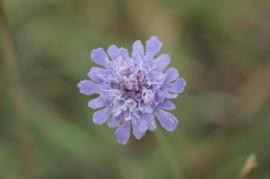Field scabious
(Knautia arvensis arvensis)

Description
Knautia arvensis arvensis, commonly known as field scabious or field scabious, is a species of flowering plant in the honeysuckle family Caprifoliaceae. It is a herbaceous perennial native to Europe and Asia, and is often found growing in meadows, fields, hedgerows, and along roadsides. The plant is popular with gardeners due to its attractive flowers and ability to attract pollinators, making it a valuable addition to any garden. Taxonomy and Etymology Knautia arvensis arvensis was first described by Carl Linnaeus in his landmark work, Species Plantarum, in 1753. The genus Knautia is named after the German botanist Christian Knaut, while the specific epithet arvensis is Latin for "of the field". The common name "scabious" comes from the plant's historic use in treating scabies, a skin condition caused by mites. Description Field scabious is a herbaceous perennial that can grow up to 60 cm tall. It has a clump-forming growth habit, with stems that are slightly hairy and reddish in color. The leaves are basal, lobed and can be up to 15 cm long. The upper leaves are alternate and stemless. The flowers are small, pink or lavender in color, and arranged in dense, spherical heads that are up to 4 cm wide. The flowers bloom from June to September, and are highly attractive to bees, butterflies, and other pollinators. Distribution and Habitat Field scabious is native to Europe and Asia, and can be found throughout the temperate regions of the northern hemisphere. It is commonly found growing in meadows, pastures, hedgerows, and along roadsides. It prefers well-drained soils that are rich in organic matter, and is tolerant of a range of soil types. Cultivation Field scabious is a popular garden plant due to its attractive flowers and ability to attract pollinators. It is relatively easy to grow, and prefers full sun to partial shade. It can be grown in a wide range of soils, but prefers well-drained soils that are rich in organic matter. The plant can be propagated by seed or by division of the root ball. Seeds can be sown directly in the garden in the spring or fall, and should be lightly covered with soil. Plants should be spaced 30-45 cm apart to allow room for growth. Uses Field scabious has a long history of medicinal use, particularly in the treatment of skin conditions such as scabies and eczema. The plant contains compounds that have anti-inflammatory and antiseptic properties, and can be made into a poultice or infusion for topical application. The flowers are also a popular ingredient in herbal teas, and can be used to make a fragrant, refreshing tea that is believed to have a calming effect on the mind and body. Conclusion Knautia arvensis arvensis, or field scabious, is a popular garden plant known for its attractive flowers and ability to attract pollinators. It is a hardy perennial that is relatively easy to grow, and can be found growing in meadows, fields, and hedgerows throughout the temperate regions of the northern hemisphere. The plant has a long history of medicinal use, particularly in the treatment of skin conditions, and the flowers are a popular ingredient in herbal teas. Whether grown for its ornamental value or medicinal properties, field scabious is a valuable addition to any garden or herbal medicine cabinet.
Taxonomic tree:







